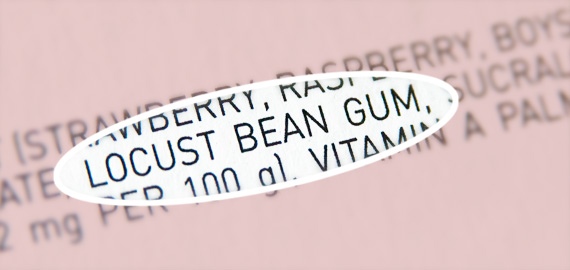Fat Replacers and Thickeners in Low-Fat Products

(HealthCastle.com) If you are a label reader, you will find that many low-fat or fat-free versions of your favorite food products contain multiple fat replacers. Because the real fat has been removed from the product, manufacturers have to use other ingredients in place of fat. What are these ingredients and what exactly do they do?
Fat Replacers and Thickeners in Low-Fat or Fat-Free Products
Modified Starch
Modified starch can be obtained from corn, tapioca, wheat, or other sources. The starch is treated in some way to change its original properties. Typically the resulting modified starch is used to thicken, stabilize, or help ingredients blend better in a product. You can often find modified starch in prepackaged low-fat or fat-free salad dressing, yogurt, ready-made sauces, and gravies.
Gums, Gums, and More Gums
As a label reader, you must have come across at least one or a few of these food gums: gum arabic, xanthan gum, guar gum, carob bean gum, or locust bean gum. There are also several gums that don't include the word "gum" in their names, such as carrageenan, cellulose, agar-agar, and alginate. Most gums are used as thickeners or stabilizers, or to provide a creamy mouth feel. Some have better heat resistance than others, while some can better tolerate lower pH and therefore can be used in acidic products such as salad dressings. A wide range of products uses food gums, such as pudding, yogurt, ready-made frosting, processed meats, ice cream, ready-made sauces or gravies, and frozen entrees. Carrageenan is prevalent in many non-dairy alternative beverages, such as soy milk and nut milk. In recent years, the safety of carrageenan as a food additive has been questioned because there are concerns that it may induce inflammation in susceptible individuals.
One of the side effects of having food gums added is the increase in the fiber content of the food. Therefore, you may see claims that are a bit odd, such as yogurt that advertises itself as "a source of fiber." If you really want fiber, eat fresh vegetables, fruits, and whole grains instead. Don't rely on added fiber in processed foods.
Gelatin
Gelatin is an animal-source food additive typically obtained from collagen derived from various animal (usually beef or pig) byproducts. Gelatin in low-fat or fat-free products helps simulate the creamy mouth feel of fat without adding calories. It can also be used as an emulsifier, thickener, or texturizer.
Mono- and Diglycerides
These are emulsifiers found in an extensive list of products including commercial baked goods, granola bars, whipped cream products, ice cream, and shortening. The concern about this additive is that the production of mono- or diglycerides may result in the formation of harmful trans fats, yet the label may claim the product to be "trans fat free" because the labeling law only requires that manufacturers report trans fat levels of lipids. Mono- and diglycerides are classified as emulsifiers and therefore are exempt from the labeling requirement.
The Bottom Line
The prevalence of low-fat or fat-free products is partly the result of a collective fat phobia; fat is perceived as "evil" because of its high caloric density (9 kcal per g). However, fat has multiple functions in food. It is a carrier of fat-soluble vitamins. It also helps the bioavailability of some phytonutrients, provides the creamy mouthfeel of many desserts and sauces, and is the carrier of many pleasant flavor compounds that increase the palatability of the foods we eat. In wheat-based baked goods, fat helps interrupt gluten formation and therefore helps certain products attain a softer, flaky texture (such as pie crust). Our bodies actually need fat (albeit the right kinds of fat) to function.
Many fat replacers are not rigorously studied for safety. If you were to ask us, when faced with the choice between full-fat or fat-free, we would say go for the real thing. Just be aware of the high caloric density of a full-fat product, and use occasionally in a reasonable amount. If you look at the list of fat replacers above, while the calories may be reduced by the removal of fat, what has been added back in isn't exactly spectacular. As an example, with modified food starch, naturally occurring fat is removed in favor of more processed carbohydrates in the final product.
-
Make A Preemptive Strike Against Christmas Weight Gain
The summer holiday season is over in the northern hemisphere; the
-
6 Easy Tips For Weight Loss
More and more people in the world are getting over weight, which al
-
10 Easy Ways to Cut Calories in Your Diet (Without Going Hungry)
Whether youre trying to lose weight or just keep from gaining weight,
-
Weight Loss Without Hunger Pains
Diets and exercise alone are the prescription to something that many p
-
Great Advice For Creating A Home Business
{If someone told you that you could start up a business today at home
-
Losing Pregnancy Weight – The Smart Way
by Teresa Brown Is image everything in today’s society? Image r
- DON'T MISS
- Slim to None: The Dangers of Rapid Weight Loss Plans
- Effective and Natural Ways to Lose Visceral Fat Fast
- Nutrition: The Super Foods that keep you Healthy
- Why People Like the Acai Berries
- Curried Lentil Soup
- Weight Loss: Chelsea Clintons Wedding--Whos Fat?
- How to Practice Self-Love and Reach Your Weight Loss Goals
- Is Weight Loss Possible With Exercise Alone?
- Lap Band Weight Loss Surgery
- Treatment For Eating Disorders in Adolescents




